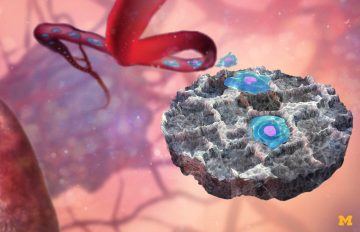Moore and Lynch in Michigan News:
 ANN ARBOR—Invasive procedures to biopsy tissue from cancer-tainted organs could be replaced by simply taking samples from a tiny “decoy” implanted just beneath the skin, University of Michigan researchers have demonstrated in mice. These devices have a knack for attracting cancer cells traveling through the body. In fact, they can even pick up signs that cancer is preparing to spread, before cancer cells arrive. “Biopsying an organ like the lung is a risky procedure that’s done only sparingly,” said Lonnie Shea, the William and Valerie Hall Chair of biomedical engineering at U-M. “We place these scaffolds right under the skin, so they’re readily accessible.”
ANN ARBOR—Invasive procedures to biopsy tissue from cancer-tainted organs could be replaced by simply taking samples from a tiny “decoy” implanted just beneath the skin, University of Michigan researchers have demonstrated in mice. These devices have a knack for attracting cancer cells traveling through the body. In fact, they can even pick up signs that cancer is preparing to spread, before cancer cells arrive. “Biopsying an organ like the lung is a risky procedure that’s done only sparingly,” said Lonnie Shea, the William and Valerie Hall Chair of biomedical engineering at U-M. “We place these scaffolds right under the skin, so they’re readily accessible.”
The ease of access would also allow doctors to monitor the effectiveness of cancer treatments closer to real time.
The U-M team’s most recent work appears in Cancer Research, a publication of the American Association for Cancer Research. Biopsies of the scaffold allowed researchers to analyze 635 genes present in the captured cancer cells. From these genes, the team identified ten that could predict whether a mouse was healthy, if it had a cancer that had not begun to spread yet, or if a cancer was present and had begun to spread. They could do that all without the need for an invasive biopsy of an organ. The gene expression obtained at the scaffold had distinct patterns relative to cells from the blood, which are obtained through a technique known as liquid biopsy. These differences highlight that the tissue in these traps provides unique information that correlates with disease progression. The researchers have demonstrated that the synthetic scaffolds work with multiple types of cancers in mice, including pancreatic cancer. They work by luring immune cells, which, in turn, attract cancer cells.
More here.
